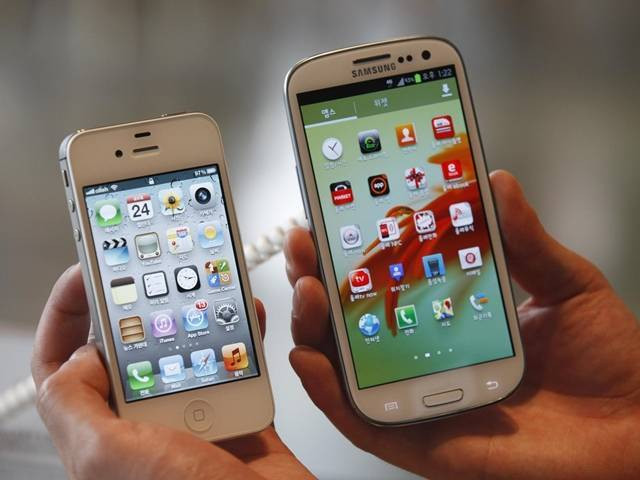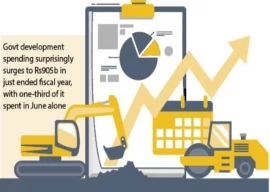
Samreen Babar, a resident of Gulshan-e-Hadeed, has been feeling ‘connected’ ever since she bought a smartphone last month.
The 32-year-old housewife now uses her new gadget to connect with her sister-in-law in London, talk to her brother in Germany and keep abreast of social media updates of her family and friends through Skype, WhatsApp and Facebook.

Though she bought the gadget to connect with her family, she also uses the device to watch her favourite tv show online, making up for episodes she misses during her hectic daily routine.
To post or not to post: Defiant Pakistani teens' growing dilemma
Samreen is part of the age group (18-34) that has been driving the growth of Pakistan’s smartphone market as it moves from basic feature phones to more advanced smartphones.
This shift is largely facilitated by growth of the mobile broadband industry, which has been connecting more than 1 million new users to high-speed internet every month since the launch of 3G and 4G technologies.
The growth of mobile broadband has not only created a massive demand for smartphones but also opened up a world of opportunities for the country: access to social media apps, education, healthcare and other services, employment opportunities, and social and political awareness to name but a few.
The current practice
With the rollout of mobile broadband technology completing its second year this April, The Express Tribune takes a look at the trends in the country’s smartphone market, which has been growing on the back of broadband adoption by users in large numbers.
Smartphones to replace cards at bank machines
Unlike five years ago, when people would visit Karachi’s largest mobile phone market in the downtown area of Saddar, people are now buying their phones from small shops in their own area, says Shaniyal Sabir who runs a mobile phone shop in Clifton. There are four to five shops in every neighbourhood now, he adds.

A drive across Karachi will only endorse Sabir’s statements. Dozens of new markets have opened up in every commercial area of the city, indicating how the supply side is now feeding the growing demand for smartphones.
The trend holds true for Lahore, Pakistan’s second largest city.
Lahore’s mobile phone market, which was limited to Hafeez Center and Hall Road, has spread all over the city, says Rana Haris, owner of Future Mobiles — one of the largest mobile dealers in Lahore. Every town of Lahore now has its own mobile market, he said. This rapid rise of mobile phone shops and wholesale markets is due to the increase in demand, not only from Lahore, but also from adjacent cities, he added.
The top 10 smartphones of 2015 to get your hands on
According to the Pakistan Telecommunication Authority (PTA), smartphones now account for half the country’s total mobile phone imports, a dramatic increase from 7% at the end of fiscal year 2012. Smartphone shipments to Pakistan increased by 123% in 2015, one of the fastest growth rates for smartphone imports in Asia and Africa region, according to the International Data Corporation Report, 2015.
So how big is Pakistan’s mobile phone market?
There is no credible data available to answer this question, but statistics of the country’s mobile phone imports through legal channels provide a close estimate of its formal market.

Based on mobile phones’ average selling price, which comes to around $45, Pakistan has a mobile phone market of $840 million a year as per September-2015 mobile phone imports, which stood at 1.53 million units, reveals an independent market research.
Pakistan to have 40 million smartphones by end of 2016
The research estimated that the country’s mobile phone imports during the 12-month period ended September, 2015 ranged between 1.4 and 1.7 million units a month, according to the report. However, these statistics do not cover mobile phones that make their way into the country through grey channels and expats who bring mid- to high-end phones for their friends and family.
Mobile phones entering the country through informal channels are worth another $1 billion, says Parvez Iftikhar, an Islamabad-based expert on Information and Communications Technology.
The largest mobile phone brand in Pakistan
When it comes to mobile phone vendors, Qmobile emerges as the largest mobile phone selling brand accounting for more than half of the country’s total mobile phone imports. From just under 50% or 839,000 units in September 2014, Qmobile’s market share (in imports) increased to 57% or 864,000 units in September 2015.
Nokia – the Finish mobile phone maker, which had been the undisputed leader until Qmobile took over – was the second largest mobile phone brand with a market share of 13.6% or 200,000 plus units in the month under review.
What happens to your smartphone once stolen?
“I think Nokia has become victim to its own success,” Iftikhar said, explaining its decline in Pakistan, which is in line with the global trend. It didn’t evolve and relied on its own operating system, Symbian. Even after Microsoft’s takeover of the company, it continued with Windows OS while Android was making headway, he said, adding the company will soon be beaten by Chinese phones that are flooding the Pakistani market.

Nokia’s imports in Pakistan declined by more than a half between September 2014 and September 2015 – down from 29% at the start of the period to less than 14% at the end of it.
The year-long trend indicates Samsung will soon surpass Nokia – if it has not already happened. During the same one-year period, Samsung grew its market share from 6.6% or 111,000 units to 11.3% or 173,000. The data is five months old and the company now imports 300,000 units a month, according to one of its officials, and accounts for more than 80% of the high-end market segment.
Is Qmobile dominating every price segment? Not really
It is difficult to figure out which company is the largest smartphone brand because of varying definitions. For example, some experts say a mobile phone with WiFi or 3G connectivity is a smartphone while others attribute them to their price.
There is even mixed opinion regarding what counts as brand. For example, some vendors do not count Qmobile among branded smartphones because of its business model – the likes of Qmobile are considered white label phones, which are manufactured by Chinese companies and imported and distributed by local vendors as their own brand.
However, we have tried to pick up market leaders based on the price bands they have been dominating in the country.
A breakdown of different price bands for July-September quarter of 2015 indicates that Samsung is dominating the mid- to top-tier smartphone market segment with Apple accounting for a share of the pie as well. The Korean cell phone giant accounts for more than half the market when it comes to smartphones selling above $150 – this goes as high as 90% in $300-$400 price band.
The second largest brand in the aforesaid category was Huawei – the Chinese cellular giant was close competition of Samsung in $225-$300 price band in the same period. However, as the prices go down, the competition gets stiffer with Qmobile dominating most price bands below $100.
A breakdown of data shows the $100-$150 price band is almost evenly divided between Qmobile and Samsung that were in neck-to-neck competition with each other during the quarter under review. Similarly, Nokia and Qmobile are in close competition for mobile phones selling between $30 and $75.
Impact on ecommerce
Smartphones are the highest selling category on almost every ecommerce website in the country.
Interestingly, the major ecommerce players now get half of their traffic from mobile phones, which are driving their growth.
Currently valued at over $60 million, the country’s e-commerce sector is doubling in size every year. It is growing at a compound annual growth rate (CAGR) of over 100%. Industry analysts predict this trend (rate) will continue during the next three to five years and help the sector surpass the $1-billion milestone in 2020.
The outlook
“Going forward, I see a phenomenal growth in smartphone penetration,just like black and white movies were replaced with colour films,” said Iftikhar. The ICT expert added that 2015 was good for telecom growth, which was in line with global trends. But this growth can be much faster, he said, adding that if the government removes or lowers entry barriers, this would allow more people to access internet. Import duties on mobile phones and telecom equipment, taxes on credit re-charge and taxation on telecom services are hindering growth of broadband, he said.
The government is aware that cellular mobile operators will not invest in network expansion to remote areas nor buy bid for more spectrum unless their concerns regarding taxes are addressed, Iftikhar said.
With additional reporting by Shahram Haq in Lahore
Published in The Express Tribune, March 7th, 2016.
Like Business on Facebook, follow @TribuneBiz on Twitter to stay informed and join in the conversation.


















COMMENTS
Comments are moderated and generally will be posted if they are on-topic and not abusive.
For more information, please see our Comments FAQ